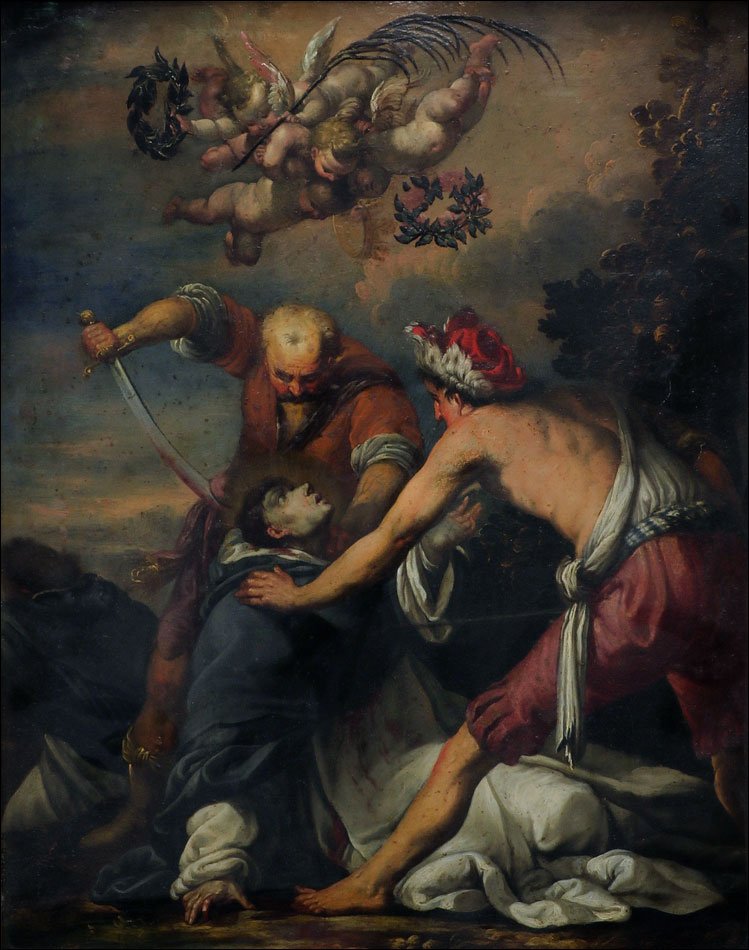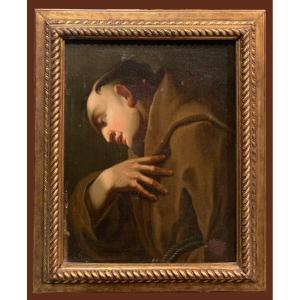Saint Peter of Verona, known as Saint Peter Martyr, was a 13th-century Dominican friar who dedicated his life to combating the Cathar belief in Lombardy. Born in Verona in 1205, he was murdered in 1252 by order of his doctrinal enemies while traveling to Milan. His death was sudden and violent, caused by a sword that pierced his head. According to tradition, as he lay dying, he wrote the word "Credo" (I believe) on the ground with his own blood before passing away and joining Jesus, expressing his belief that Death was not the end but only the beginning. He was canonized the following year, in an exceptionally swift process.
During the Renaissance and especially the Baroque period, his figure was fervently promoted by the Dominican Order as an example of absolute devotion to faith. His martyrdom iconography was codified from the 16th century, appearing in works by Titian, Veronese, Domenichino or Ribera, who depicted him almost always kneeling at the moment of the blow, with descending angels bearing the symbols of martyrdom.
In 17th-century Naples, this theme was treated with special sensitivity by artists like Andrea Vaccaro and Luca Giordano, whose works combined theatricality, psychological depth and technical mastery. In this context, many devotional oils on copper emerged, intended for private collections or small chapels, where narrative and symbolism had to be condensed in small yet powerful formats.
This painting, clearly connected to that tradition, condenses in just 37 centimeters the full force of a universal story: sacrifice for faith, triumph over death and the promise of redemption that shines even amidst horror.
The scene is structured around a strong ascending diagonal that links earth, with its violence and rawness, to heaven, bearer of promise and redemption. At the bottom, Saint Peter kneels calmly while one of his executioners holds him and the other raises a scimitar in the instant before the fatal blow. His grey-toned Dominican habit is starting to stain with blood, but the saint's face, bathed in warm, supernatural light, expresses devotion rather than pain.
At the top of the composition, three angels descend from heaven, sent by God to receive the martyr's soul at the very moment of his passage. They do not come as mere spectators, but as bearers of eternal promises: one holds the palm of spiritual triumph, another raises a laurel wreath, while a third presents a second laurel wreath, and a fourth figure lifts a golden crown—the ultimate symbol of heavenly glory granted to those who have remained steadfast in faith. Bathed in soft, enveloping light, these angels form a true divine court, a solemn celestial welcome that contrasts with the brutal violence below. Their presence not only balances the composition, but elevates its meaning: martyrdom is not an end, but the beginning of glorification.
The choice of copper as support is significant: its polished surface allows for subtle reflections in the wings, drapery and skin tones. The paint is applied in light layers with smooth transitions, showcasing the hand of a master cabinet painter able to convey both drama and elegance. The technique, which combines Ribera-like tenebrism with post-Caravaggist classicism, is representative of the Neapolitan school in the mid-17th century.
The state of preservation is excellent: the paint layer is perfectly adhered, with no losses or lifting. The varnish shows a light yellowish patina in the lighter areas, consistent with its age, and only minimal old retouching is visible around the edges. The reverse side of the copper shows an elegant patina, with no corrosion or deformation.
The frame, carved in wood and gilded with mixtion, was made in the late 19th or early 20th century. Its stylised garlands and vegetal reliefs complement the painting without overpowering it.
Due to its intimate format, high technical quality and deep symbolic charge, this devotional work was clearly intended for a private oratory or a cultured collection. Its visual power and balance make it an exceptional acquisition for collectors of Baroque art or for sacred contemplation spaces.
Dimensions: 37 × 29 cm (14.57 × 11.42 in). With frame: 46 × 38 cm (18.11 × 15 in).
We are professional antique dealers. To see more photos of this item, please click on this link:
https://www.antiguedades.es/en/antique-painting/5312-antique-oil-on-copper-saint-peter-of-verona-neapolitan-italian-school-circa-1650.html






































 Le Magazine de PROANTIC
Le Magazine de PROANTIC TRÉSORS Magazine
TRÉSORS Magazine Rivista Artiquariato
Rivista Artiquariato